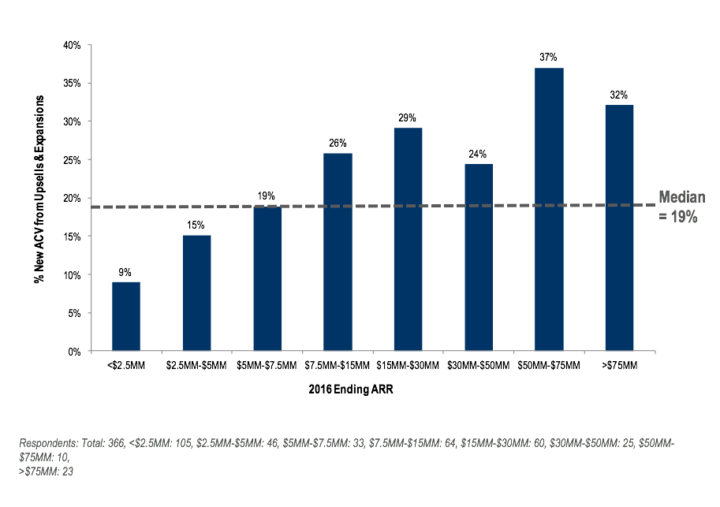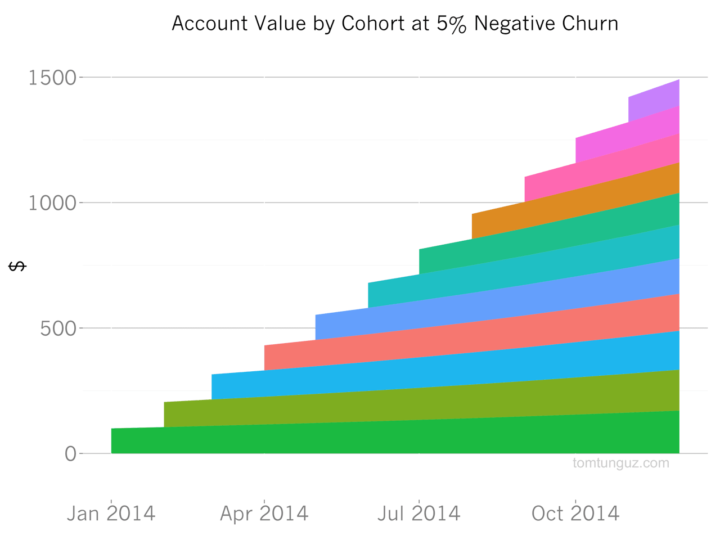“Expansion MRR shows if the company can deliver more and more value to customers and monetize that value. Being able to generate expansion MRR is extremely valuable, especially longer term. Most of the best later-stage SaaS companies get a significant portion of their growth from existing customers.”
Christoph Janz, Point Nine Capital
Definitions
Expansion in SaaS is often overlooked. It’s actually a highly useful leading indicator of success, and can often be used in an actionable way. When it comes to measuring expansion, there’s a single metric that’s usually used:
MRR Expansion Rate
MRR expansion rate is the additional MRR generated for your business that comes from existing customers, usually in the form of add-ons or up-sells. As with most SaaS metrics, we always measure expansion rate across a fixed period:

What’s a healthy expansion rate?
There isn’t much in the way of benchmarks on SaaS expansion rate, but the 2017 Private SaaS Company Survey from KBCM Technology Group and forEntrepreneurs does give some insights into the proportion of revenue coming form expansion:

In this chart we can see that the median percentage of ARR coming from upsells and expansions is 19%.
How to increase expansion rate
Expansion is really a part of the DNA of any SaaS business. Achieving a healthy expansion rate means building expansion into your pricing model.
There are a number of ways to do this, such as implementing scalable pricing (e.g. paying per user account or proportional to revenue). You can also offer a more modular pricing model that incorporates add-ons. This gives you a good opportunity to up-sell or cross-sell existing customers. Keeping customers happy and driving expansion at the same time means making expansion predictable for them. Surprise upgrades aren’t cool.
The benefits of a healthy expansion rate
Balance increasing acquisition cost: The acquisition cost for new business MRR is far higher than that of expansion MRR. Existing customers are, by definition, much more attuned to the value of your product and are the warmest leads you’ll ever deal with. Customer acquisition cost (CAC) is steadily increasing in the SaaS industry, so balancing this with strong revenue expansion is desirable.
Decrease payback period: The result of a lower acquisition cost for expansion revenue means that the payback period is much shorter. Decreasing your payback period means that less cash (risk) is tied up in the company and cash flow is generally healthier.
The 2017 Private SaaS Company Survey also illustrates the relative CAC of new business vs. upsells and expansions:

Identify high-value customers: With expansion built into your pricing, you’re giving customers the chance to grow and see increasing value from the product over time. Identifying those high-LTV customers who stick with you and expand over time is incredibly useful — in part for modelling your ideal customer profile.
“The best kinds of customers are those who grow with your product. These kinds of customers are in it for the long haul, because they grow through the ups and downs of your product. They are the most loyal ones and wait for each product release with anticipation.”
Expansion’s role in negative churn
Achieving a negative MRR churn rate in SaaS is in many ways a badge of honor. A healthy expansion rate is a primary ingredient in negative churn (the other one being low MRR churn rate).
“Negative churn is an incredibly attractive characteristic of a SaaS company because it means that customer accounts are like high-yield savings accounts. Every month, more money comes in, without much effort. This is a powerful effect and can fuel SaaS companies to huge success.”
Tomasz Tunguz
Negative churn occurs when expansion MRR exceeds gross MRR churn rate, and it can have a huge impact on growth as illustrated in this chart from Tomasz Tunguz:

Resources and Further Reading
BASICS
Lifecycle of a customer (ChartMogul) — This help center article, while designed to give an overview of the complete lifecycle of a subscription customer, lays out some different categories of expansion.
Future Proofing: How To Model SaaS Pricing For Expansion MRR (Chargify) — An excellent article from the team at Chargify on how to design your pricing around healthy expansion.
DEEP CUTS
Useful ways to analyze SaaS expansion (ChartMogul) — The goal of this post is to really demonstrate how expansion can be actionable for SaaS businesses. There are some more advanced measurements of expansion here that definitely go beyond the basics.
